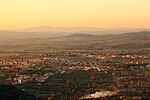Massa Marittima Cathedral
Cathedrals in TuscanyChurches in the province of GrossetoMassa MarittimaRoman Catholic cathedrals in ItalyRoman Catholic churches in Tuscany ... and 1 more
Romanesque architecture in Tuscany

Massa Marittima Cathedral (Italian: Duomo di Massa Marittima; Cattedrale di San Cerbone) is a Roman Catholic cathedral in Massa Marittima, Tuscany, Italy, dedicated to Saint Cerbonius. Formerly the episcopal seat of the Diocese of Massa Marittima, it is now that of the Diocese of Massa Marittima-Piombino.
Excerpt from the Wikipedia article Massa Marittima Cathedral (License: CC BY-SA 3.0, Authors, Images).Massa Marittima Cathedral
Piazza Giuseppe Garibaldi,
Geographical coordinates (GPS) Address External links Nearby Places Show on map
Geographical coordinates (GPS)
| Latitude | Longitude |
|---|---|
| N 43.0497 ° | E 10.8879 ° |
Address
Cattedrale di San Cerbone
Piazza Giuseppe Garibaldi
58024
Tuscany, Italy
Open on Google Maps










